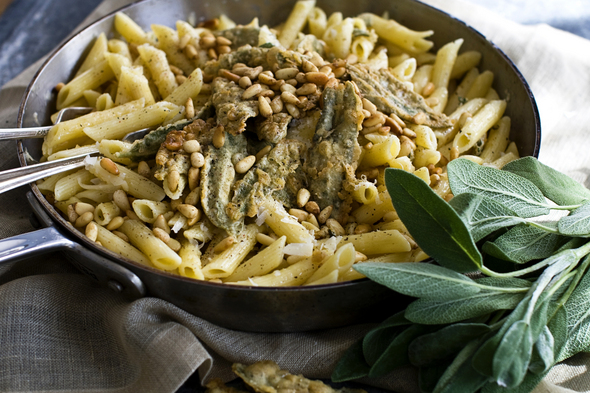Fresh sage: What it is and how to use it

When shopping for sage, look for leaves that are tender-firm with a downy coating and no brown spots.
AP Photo | Matthew Mead
It's hard to not love an ingredient that loves fat.
And that's exactly what sage does — it partners perfectly with foods rich in oils and fats. That's why it is so common in hearty holiday foods.
Actually, that's part of sage's problem, and why it has a relatively low profile in American cooking compared to other savory herbs, such as basil and oregano. While we think of all manner of uses for other herbs in all seasons, we tend to pigeonhole sage as a Thanksgiving herb suited mostly for stuffing and turkey.
But the richly peppery-rosemary flavor of fresh sage can more than earn its keep all year. You just need to know how to use it.
Let's start with what it is. Sage is a perennial related to mint. There are many varieties, including pineapple-flavored sage from Mexico (best suited for desserts). Sage generally is sold in three forms — fresh, dry ground and rubbed.
Fresh is pretty self-explanatory. When shopping for it, look for leaves that are tender-firm with a downy coating and no brown spots.
Rubbed is dried sage leaves that have been quite literally rubbed off the stems. It tends to be pillowy soft and retains flavor well.
Dry ground sage is the least appealing of the three. It has a more muted flavor and doesn't hold up well in cooking. Skip it.
So what to do with sage outside of Thanksgiving? Just look oversees. Because sage pairs so well with dairy, the English have long made a sage-flecked cheese known as sage Derby. So take their cue and add a few fresh sage leaves to your next grilled cheddar sandwich.
The English also like to use sage with sauteed onions, usually destined for a stuffing. So why not toss fresh sage into caramelized onions, then use them to top a pizza with gouda?
In Germany, sage lands in sausages. And sometimes beer. Not sure about the last one, but I'm inclined to borrow the sage and caramelized onions from England and spoon them into a bun with a grilled sausage. In Italy, sage rules saltimbocco and osso bucco. But it's also a natural with butter-drenched pasta.
For more ideas for using sage, check out the Off the Beaten Aisle column over on Food Network: http://bit.ly/L6kzQq
Fried Sage and Parmesan Penne
A great example of how the simplest of dishes can be so overwhelmingly good. For a heartier version of this dish, add cooked chicken or apple-chicken sausage.
Start to finish: 20 minutes
Servings: 4
1 pound penne pasta
1 egg
2 tablespoons all-purpose flour
Salt and ground black pepper
12 large fresh sage leaves
4 tablespoons butter
1/3 cup pine nuts
1 cup grated Parmesan cheese
Bring a large saucepan of salted water to a boil. Add the pasta and cook according to package directions. Reserve 1/4 cup of the cooking water, then drain the pasta, return it to the pot, cover and set aside.
Meanwhile, in a small bowl, lightly beat the egg. Place the flour in a second bowl, then mix a bit of salt and pepper into it.
One at a time, dunk each sage leaf first in the egg, then in then in the flour. Shake off any excess flour, then set aside.
In a small skillet over medium-high, melt the butter. When it just starts to bubble, add the sage leaves and fry for 1 to 2 minutes per side, or until lightly browned. Transfer to a plate and set aside. Add the pine nuts to the skillet and toast in the butter that remains in the pan for 1 minute.
Drizzle the butter and pine nuts over the cooked pasta. Sprinkle in the Parmesan and use tongs to toss until melted. While tossing, drizzle in just enough of the reserved pasta cooking water to create a thick sauce. Season with salt and pepper.
Divide between serving plates, then top each portion with fried sage leaves.
Nutrition information per serving (values are rounded to the nearest whole number): 730 calories; 250 calories from fat (34 percent of total calories); 28 g fat (12 g saturated; 0 g trans fats); 95 mg cholesterol; 90 g carbohydrate; 31 g protein; 4 g fiber; 650 mg sodium.
___
J.M. Hirsch is the national food editor for The Associated Press. He is author of the recent cookbook, "High Flavor, Low Labor: Reinventing Weeknight Cooking." His Off the Beaten Aisle column also appears at FoodNetwork.com. Follow him on Twitter http://twitter.com/JM_Hirsch.


Comments
Ann English
Mon, Jul 2, 2012 : 11:02 p.m.
Sounds like the whole sage leaves are edible in their entirety, unlike bay leaves. I like dried ground sage just fine in a Whole Foods recipe called Warm Millet Salad with Brussels Sprouts, Creamed Mushrooms and Sage. Actually, the recipe calls for CHOPPED, FRESH sage. Sage in any form adds flavor to the millet, yellow onion, mushrooms and the half-and-half. I wonder if shelled sunflower seeds could be substituted for pine nuts in your recipe? Or whole-wheat flour substituted for all-purpose flour?